Half a century ago Cotoneaster horizontalis, with its fan-like sprays of stiff herringbone branches and shining red berries, graced the low wall beneath the bay window at the front of our house – as it did in most of the gardens along the road. For no effort it reliably produced its bright autumn display as the leaves turned red before falling. I remember it buzzing with bees in May and its somewhat surreal silhouette in winter. No one considered that it was an excellent source of food for wildlife. Seedlings were given by neighbours or otherwise acquired and the palette of species was limited.
Away from the suburbs, among professional horticulturists, especially shrub authorities such as Sir Harold Hillier, cotoneasters were and are
regarded as one of the most important groups of shrubs. With 400 species to choose from, they offer a diversity of habit and can be both evergreen or deciduous.
COTONEASTER: IN BRIEF
What Evergreen and deciduous shrubs of the rose family (Rosaceae), losely related to Photinia, Pyracantha, Sorbus and Crataegus (hawthorn).
Origins Around 400 species are spread across northern temperate regions including Europe, North Africa, southwest China and the Himalayas. The species have hybridised to produce many cultivars grown in gardens.
Season Small, single, white or pinkish flowers, attractive to pollinators in spring, followed by orange or red berries; occasionally yellow or pink in the case of some garden hybrids.
Size Species and hybrids vary in size from creeping groundcover shrubs, originating from alpine regions, to small trees that grow to several metres in height and spread. Most are bushy shrubs reaching two or three metres.
Conditions Tolerant and versatile shrubs that thrive on most soils including chalk and clay. Most grow quickly and are valuable for hedges.
Hardiness Most are hardy throughout the UK even in cold winters. Hardiness ratings vary from RHS H6 to RHS H7, and are suitable for gardens in USDA zones 4a to 10b.
Cotoneasters offer many of the qualities I look for in a garden plant: they are reliable, have more than one season of interest – flowers in late spring and summer, often evergreen foliage and berries in autumn and winter– and can cope with the extremes of weather. They are wildlife friendly, offering shelter to birds and insects, as well as nectar and pollen for bees and other pollinators, and food for wild birds in autumn and winter. Though they may be sometimes overlooked, they are worth seeking out.
Cotoneasters are also good plants to consider in our unpredictable climate. In my own garden, Cotoneaster salicifolius ‘Gnom’ and Cotoneaster procumbens ‘Queen of Carpets’ have coped with the tough growing conditions experienced in recent years – both in terms of temperature and rainfall extremes including drought. Their evergreen foliage looks good throughout the year and the colourful berries last well into winter.
How to grow cotoneaster
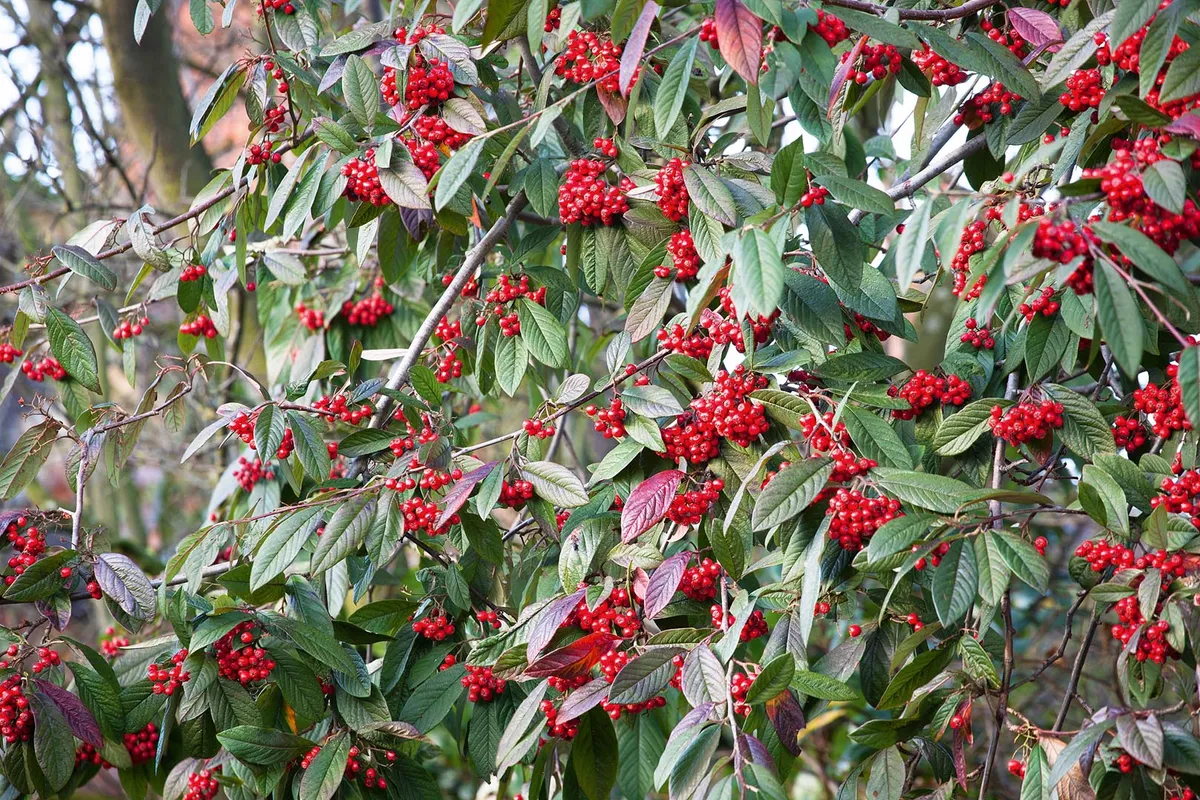
Where to plant cotoneaster
Cotoneasters are easy to grow: they are tolerant of most soils including clay, as long as it is not waterlogged, and will also grow well in dry conditions on chalk and sand. They are also ideal for new-build gardens with poor soil, where other plants might struggle.
They will thrive in sun or shade, although flowering and fruiting is usually better when a plant gets three or more hours of direct sunlight a day during the growing season.
Ground cover cotoneaster
Cotoneasters that have a low growing, prostrate habit, especially Cotoneaster horizontalis, Cotoneaster dammeri, Cotoneaster salicifolius and Cotoneaster x suecicus, are valuable evergreen ground cover shrubs that thrive in sun or shade. They are excellent on banks and slopes, embracing the contours gracefully where more upright subjects look awkward.
Cotoneaster as large shrubs and small trees
At the other end of the scale, the large-growing cotoneasters make excellent trees. Cotoneaster ‘Cornubia’ is one of the finest with broad, spreading branches and dark-green leaves. In spring it offers loose clusters of white flowers and is a magnificent sight in autumn when some of its semi-evergreen leaves turn gold and begin to fall, and large bunches of deep-scarlet berries provide a feast for wild birds. Large cotoneasters, such as Cotoneaster ‘Cornubia’ and Cotoneaster x watereri, are also perfect for screening or as large, background shrubs in wide borders. They can also be trained as medium-sized evergreen trees.
Cotoneaster for walls and fences
In a smaller garden, plants that tolerate the shade and rain shadow of walls and fences are particularly valuable. Several, including Cotoneaster franchetii, Cotoneaster x watereri and Cotoneaster frigidus, can be trained against walls for colour.
Caring for cotoneaster
Cotoneasters are undemanding when it comes to feeding and care. Cotoneasters do not need regular pruning, unless you want to control their shape and size. Ideally, this is best done in late winter or early spring. However, pruning can be done at any time of the year without causing harm.
How to plant cotoneaster
Most cotoneasters grow swiftly and soon make an impact, so choose smaller plants in two- or three-litre pots. Even if your aim is to create a hedge, you are better off with several small plants.
When to prune cotoneaster
Prune ground cover cotoneasters in early spring, to keep the growth dense and not leggy. Cotoneasters growing as small trees do not need regular pruning, but you can tidy the plant in spring.
Best cotoneaster to grow
1
Cotoneaster horizontalis
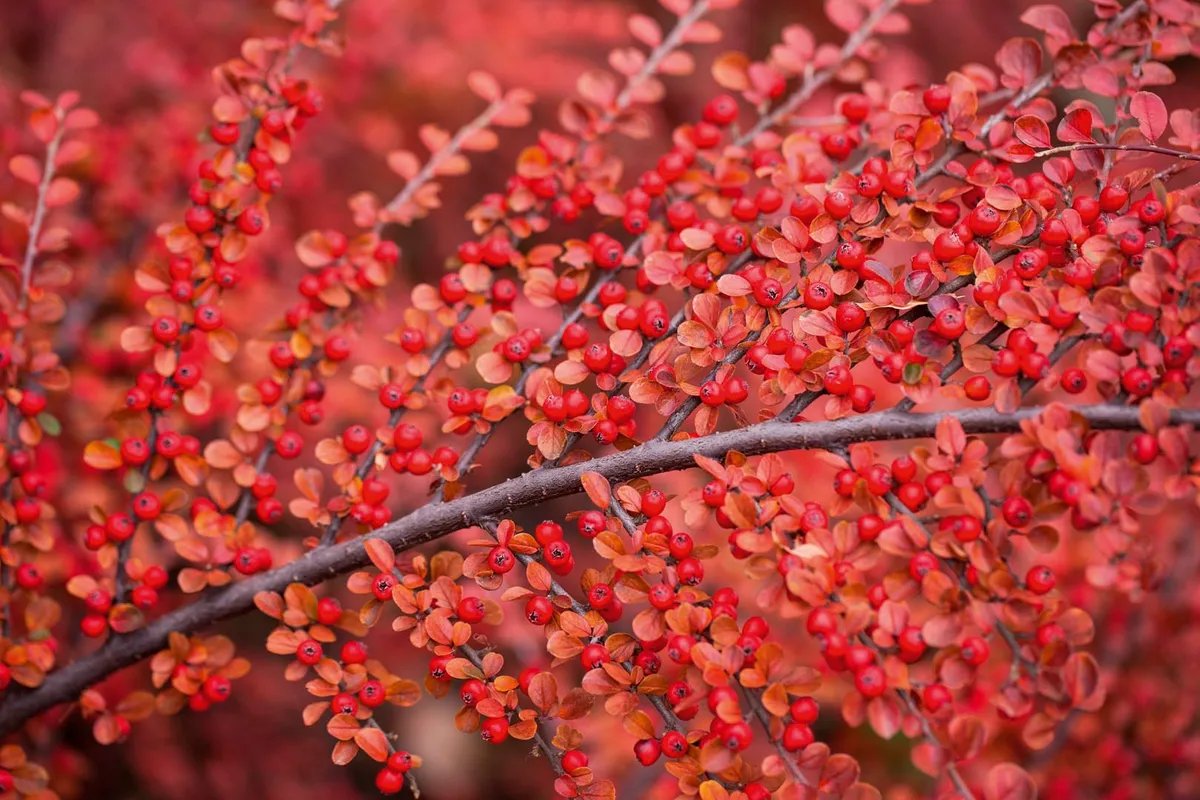
A good groundcover plant for slopes and banks, or to grow against low walls. Small, dark-green leaves turn flame red in autumn. Profuse white spring flowers develop into sealing- wax red berries in autumn. 90cm. RHS H7, USDA 5a-7b†.
Buy Cotoneaster horizontalis from Crocus
2
Cotoneaster salicifolius ‘Pink Champagne’
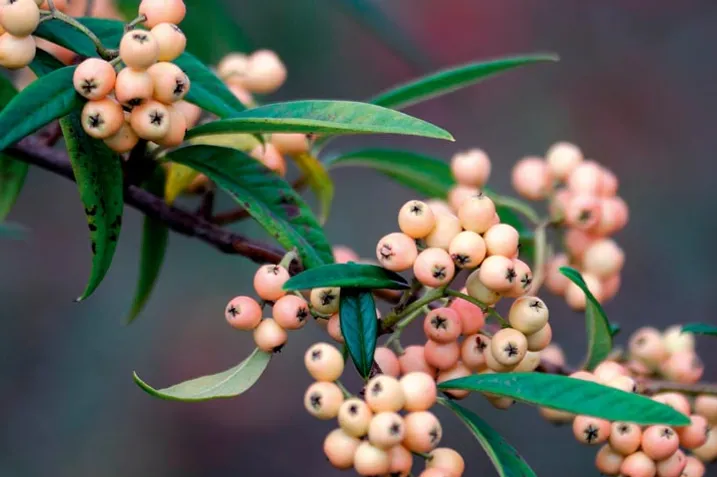
A dense, vigorous shrub with arching stems and willow-like, evergreen leaves. White flowers develop into yellow berries, turning salmon-pink with age. 2.5m. AGM*. RHS H6, USDA 7a-10b.
Buy Cotoneaster salicifolius 'Pink Champagne' from Langthorns Plantery
3
Cotoneaster x suecicus ‘Coral Beauty’
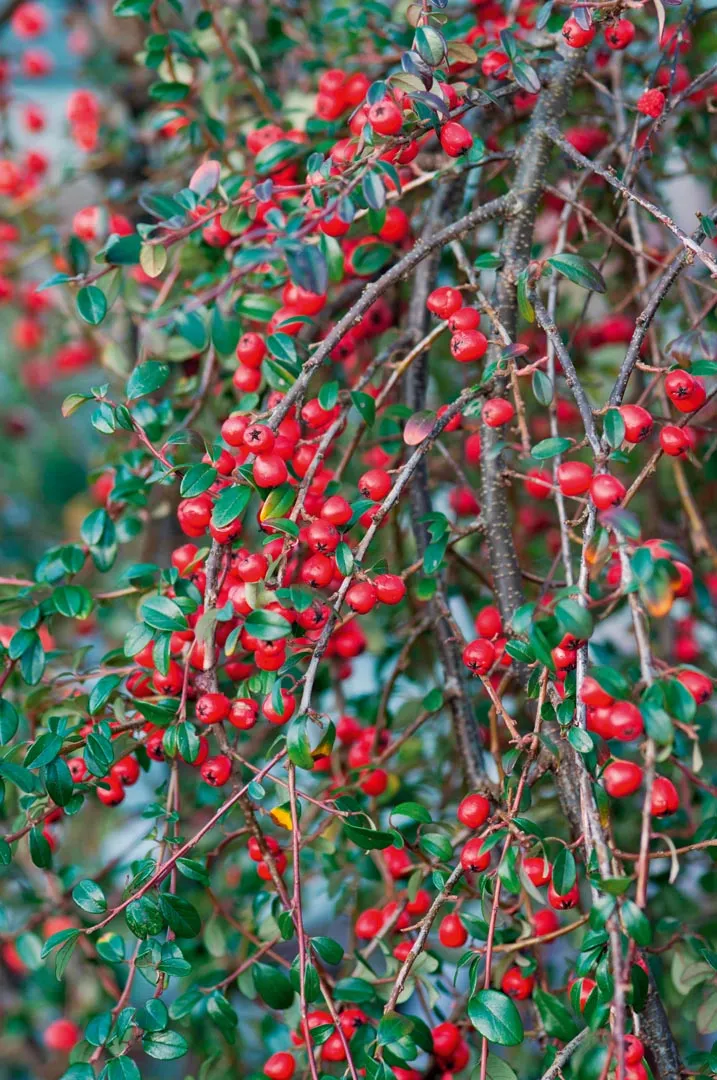
A dense, low shrub with abundant berries on arching branches of evergreen leaves that take on purple tints in winter. An attractive groundcover. 50cm. AGM. RHS H6, USDA 5a-8b.
Buy Cotoneaster x suecicus 'Coral Beauty' from Burncoose
4
Cotoneaster x suecicus ‘Juliette’
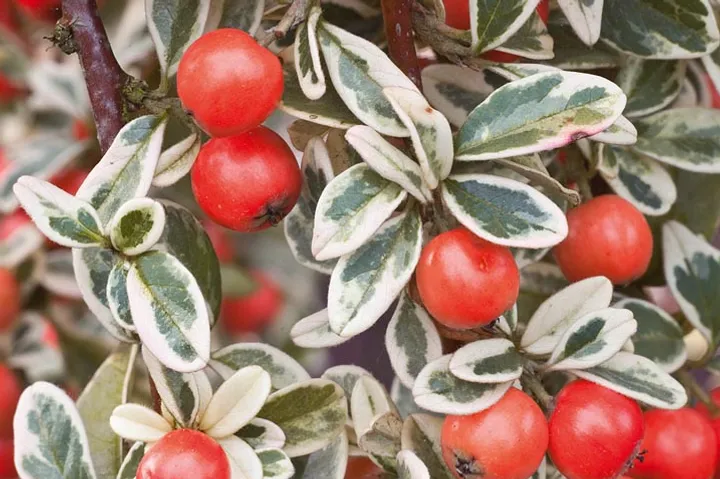
Grey-green and cream variegated leaves, and large berries. A superb plant for groundcover around large shrubs. It is also sold grafted onto an upright stem, as a small weeping tree. 45cm. AGM. RHS H6, USDA 5a-10b.
Buy Cotoneaster x suecicus 'Juliette' from Jacksons Nurseries
5
Cotoneaster frigidus ‘Fructuluteo’
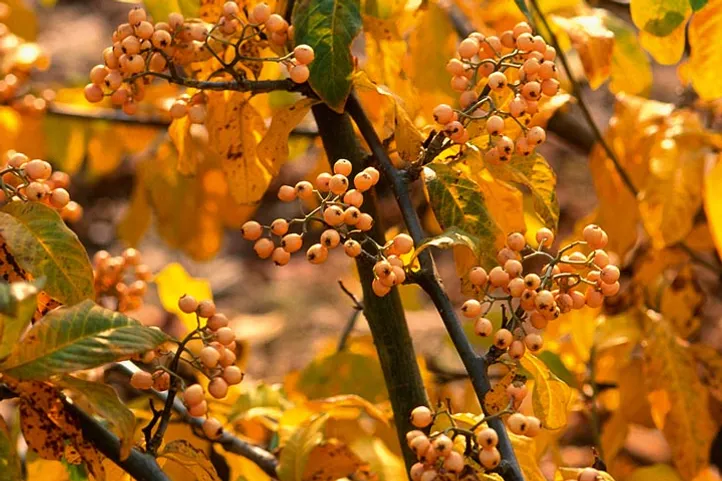
Vigorous shrub of broad, spreading habit that can grow into a tree. Clusters of white spring flowers develop into heavy bunches of creamy-yellow berries. 10m. RHS H6, USDA 6a-9b.
6
Cotoneaster dammeri
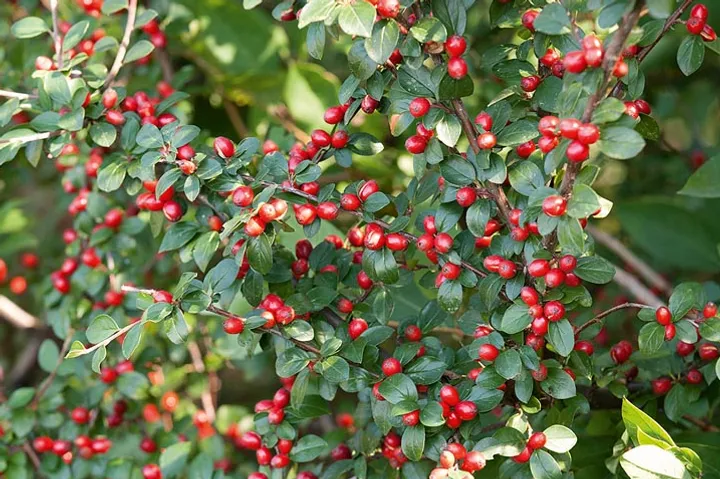
Once established, the low-creeping stems and small, dark-green leaves efficiently smother weeds and cover the soil beneath trees and larger shrubs; it will flow gracefully over low walls and on slopes and banks with white flowers in spring and scarlet berries in autumn. An excellent groundcover subject for shade. 30cm. RHS H6, USDA 5a-8b.
Buy Cotoneaster dammeri from Hopes Grove Nurseries
7
Cotoneaster ‘Rothschildianus’
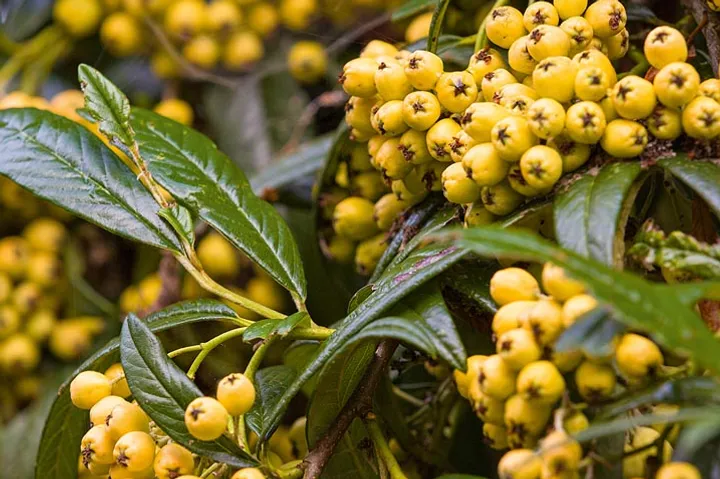
A large, spreading shrub with narrow leaves and large clusters of cream-yellow fruits in autumn. Useful plant to add colour among heavy evergreens. 5m. AGM. RHS H6.
Buy Cotoneaster 'Rothschildianus' from Bluebell Nursery
8
Cotoneaster franchetii
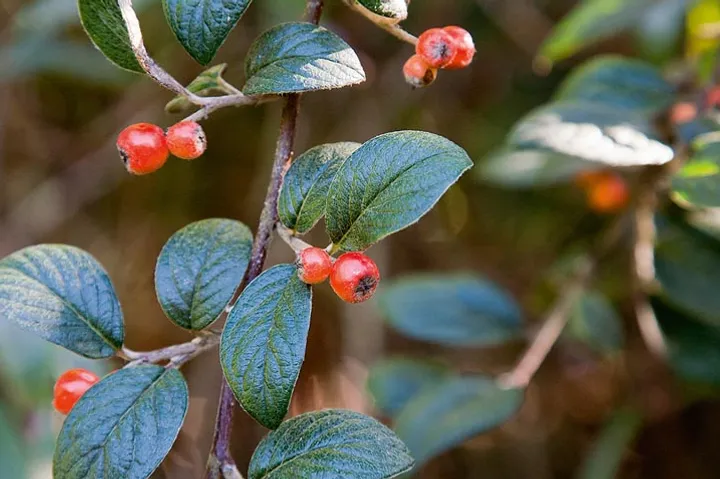
A graceful, arching and airy shrub with leaves that are green above and silver-grey beneath. Pinkish white flowers give rise to orange-scarlet fruits. Cotoneaster franchetii works well in an evergreen mixed planting or as a free-standing transitional shrub. You can use it to lighten heavy evergreens, such as laurels and mahonias, or you can use it to create a backdrop to shrub roses and perennials. It can be trimmed as a hedge or trained against a wall, and it even works well in naturalistic planting schemes. 1.8m. RHS H6, USDA 6a-10b.
Buy Cotoneaster franchettii from Jacksons Nurseries
9
Cotoneaster salicifolius ‘Gnom’
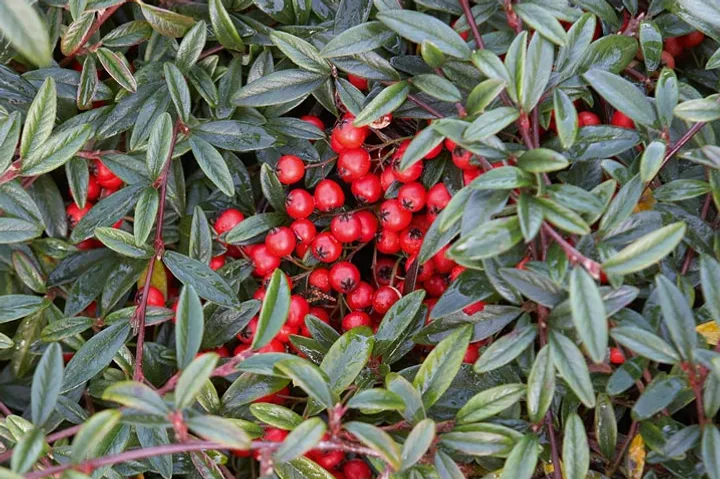
A low-growing shrub with long, trailing stems and small evergreen leaves. Small clusters of spring flowers develop into shiny orange-red berries. 45cm. AGM. RHS H6, USDA 5a-8b.
Buy Cotoneaster salicifolius 'Gnom' from Worfield Plants
10
Cotoneaster ‘Cornubia’

Perhaps the best tree cotoneaster for fruit, with bunches of scarlet berries in autumn weighing down the arching branches. Older leaves turn gold and fall as the berries ripen. 5m. AGM. RHS H6, USDA 6a-9b.
Buy Cotoneaster 'Cornubia' from Crocus
11
Cotoneaster microphyllus
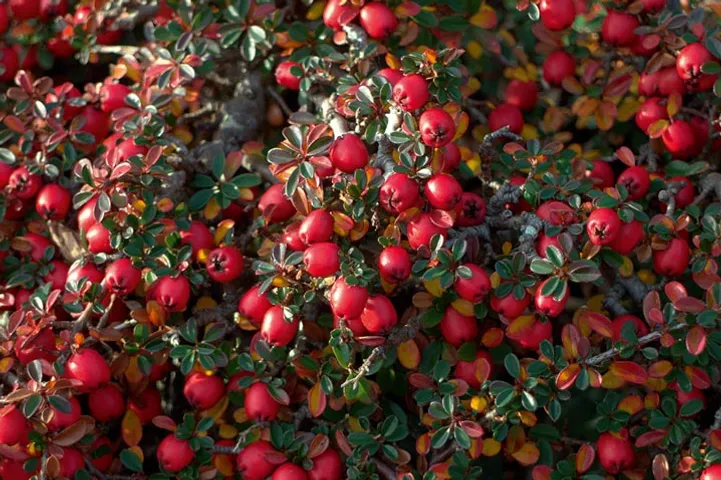
A compact evergreen shrub with stiff branches and tiny dark, evergreen leaves. A useful small shrub for rocky banks and under the light shade of deciduous trees. 90cm. RHS H6, USDA 5a-9b.
Buy Cotoneaster microphyllus from Jacksons Nurseries
12
Cotoneaster x watereri ‘John Waterer’
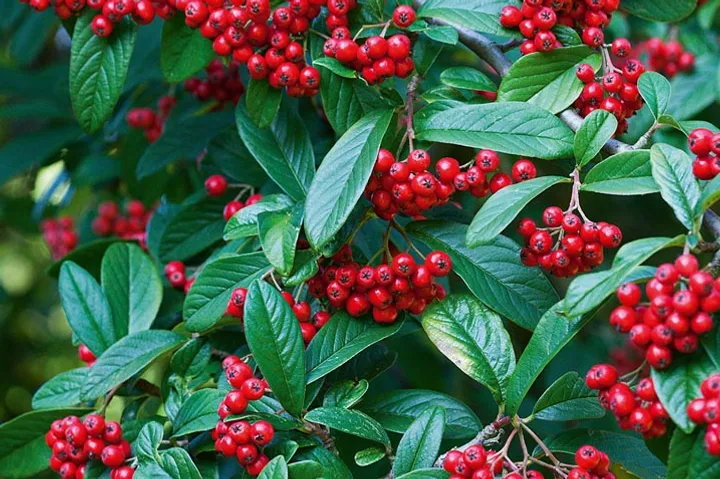
A large, semi-evergreen shrub with long, spreading branches and narrow, leathery leaves. Fruiting is prolific and provides a feast for wild birds. 3m. RHS H6, USDA 6a-9b.
Buy Cotoneaster x watereri ‘John Waterer’ from Bowhayes Trees
13
Cotoneaster atropurpureus ‘Variegatus’
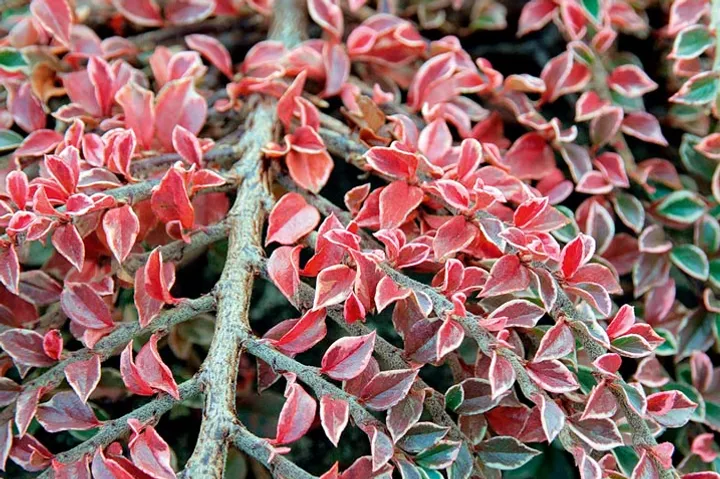
Pretty, grey-green and white variegated leaves, followed by red berries. Brilliant autumn leaf colour. Excellent for a shaded border. 60cm. AGM. RHS H6, USDA 6a-8b.
Buy Cotoneaster atropurpureus ‘Variegatus’ from Jacksons Nurseries
Where to buy and see cotoneaster
• Ashwood Nurseries, Ashwood Lower Lane, Ashwood, Kingswinford, West Midlands DY6 0AE. Tel 01384 401996, ashwoodnurseries.com
• Barcham Trees, Eye Hill Drove, Soham, Ely, Cambridgeshire CB7 5XF. Tel 01353 720748, barcham.co.uk
• Beeches Nursery, Crown Hill, Ashdon, Saffron Walden, Essex CB10 2HB. Tel 01799 584362, beechesnursery.co.uk
• Burncoose Nurseries, Gwennap, Redruth, Cornwall TR16 6BJ. Tel 01209 860011, burncoose.co.uk
• Kelways Plants, Barrymore Farm, Picts Hill, Langport, Somerset TA10 9EZ. Tel 01458 250521, kelways.co.uk
• Larch Cottage Nurseries, Melkinthorpe, Penrith, Cumbria CA10 2DR. Tel 01931 712404, larchcottage.co.uk
• The Sir Harold, Hillier Gardens*, Jermyns Lane, Ampfield, Romsey, Hampshire SO51 0QA. Tel 01794 368787, hants.gov.uk/thingstodo/hilliergardens *National Collection holder
Author Andy McIndoe is a writer, broadcaster and horticulturist.




